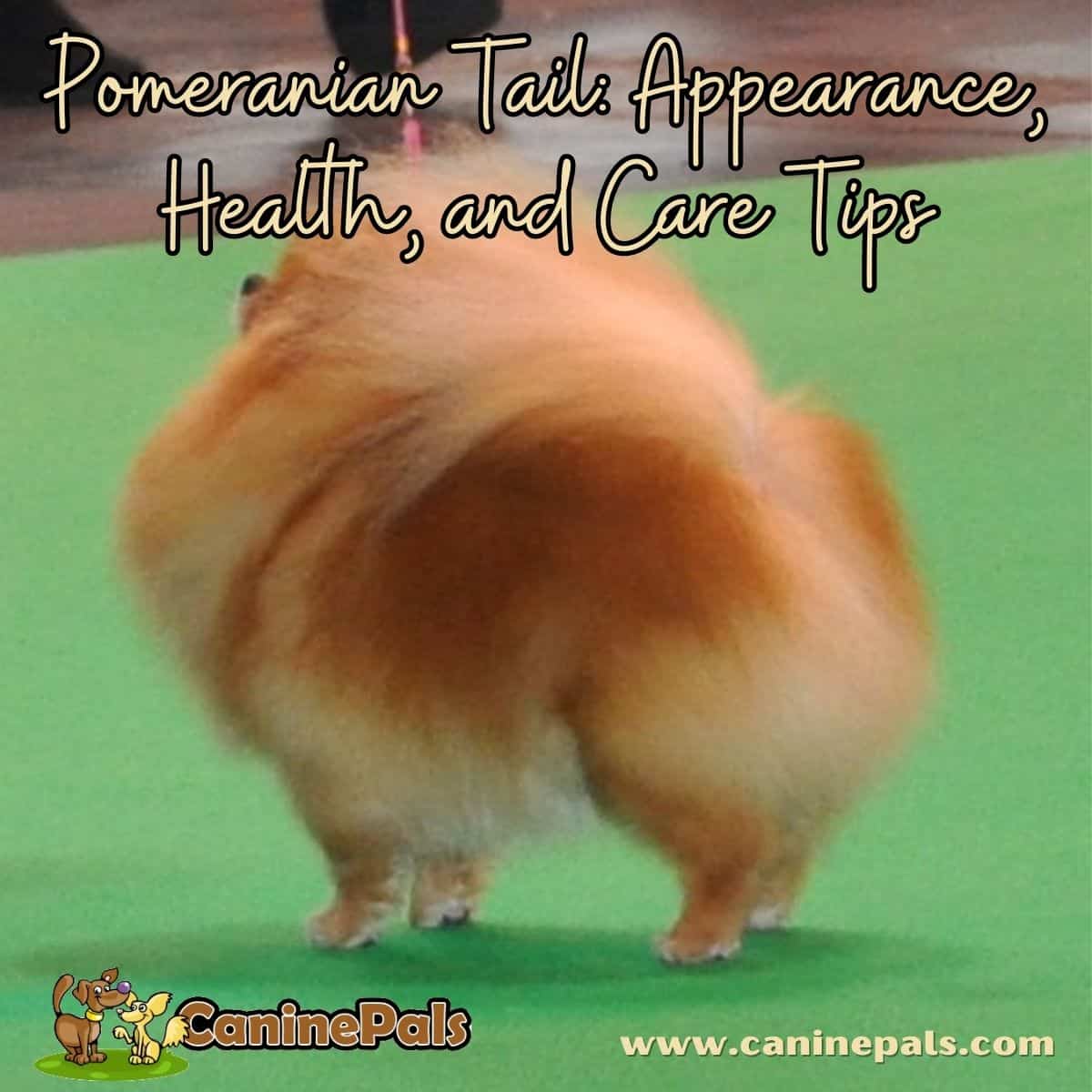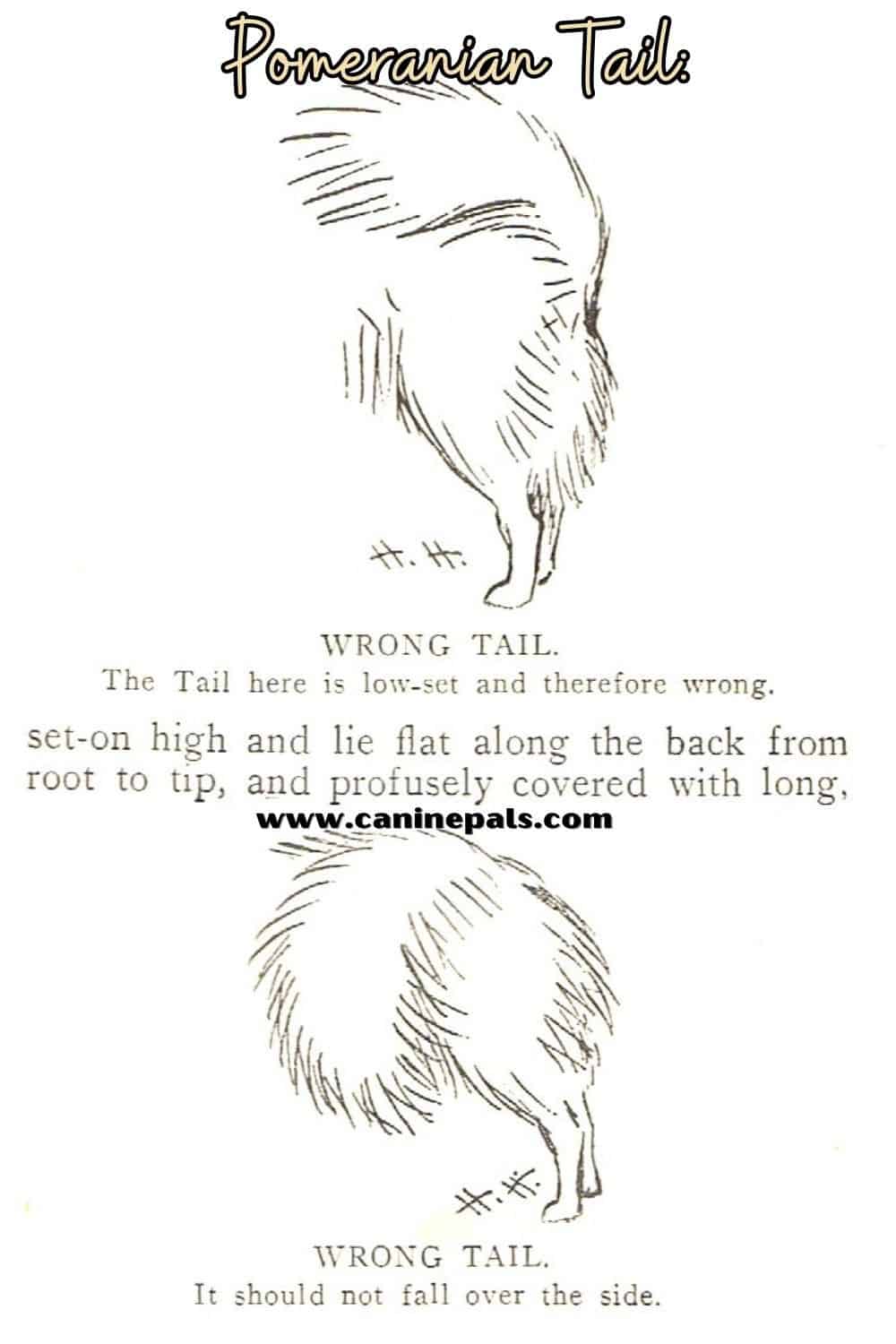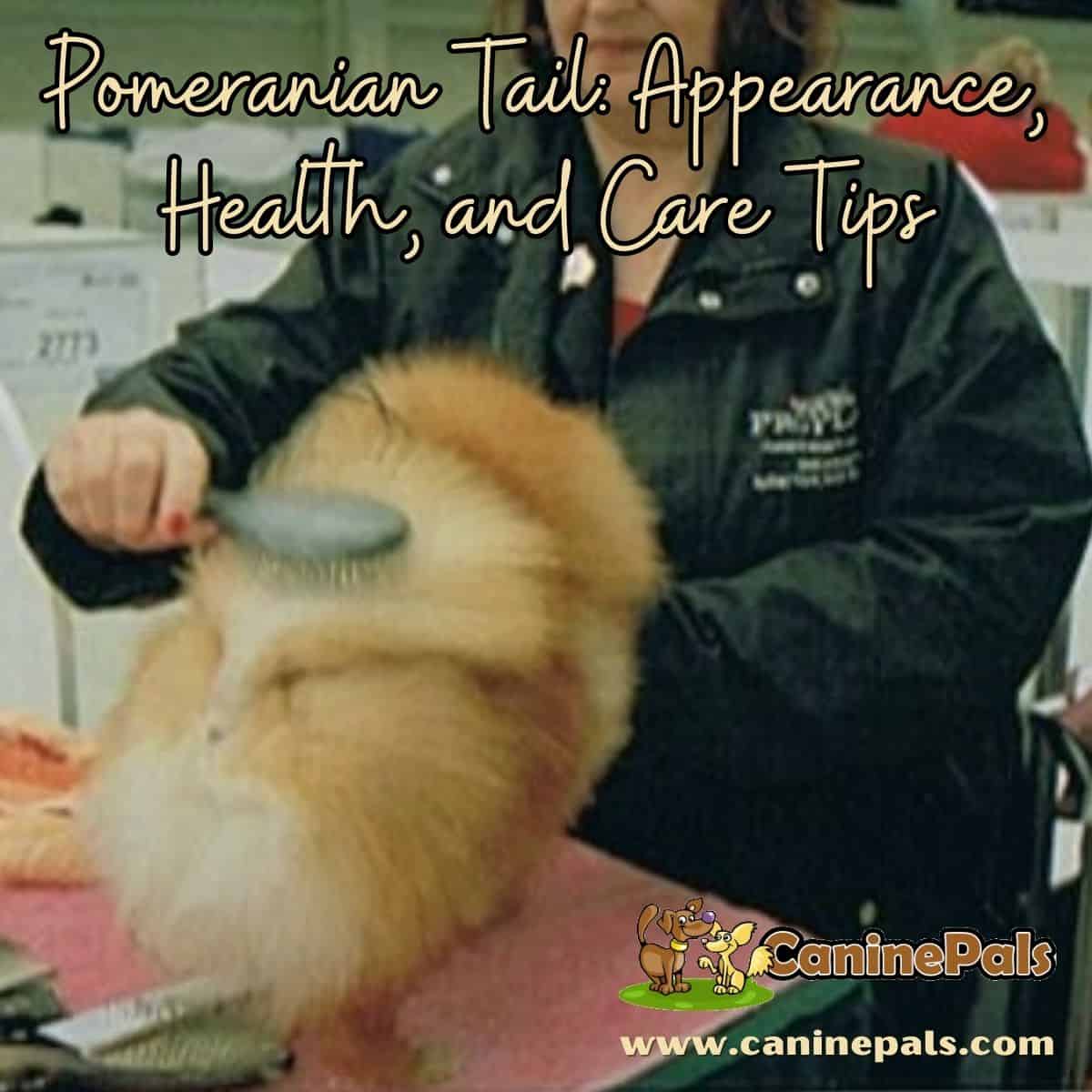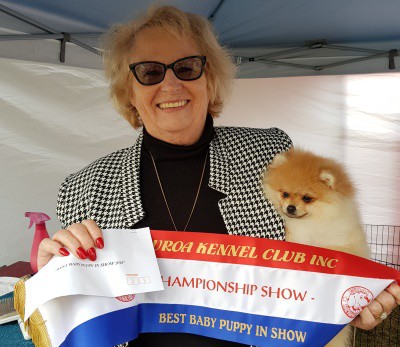Last Updated on March 19, 2024 by Denise Leo. Post first published on August 14, 2023.
The Pomeranian is known for its fluffy coat and adorable face, but its tail is just as important. The Pomeranian tail is one of the breed’s defining features. The Pomeranian’s proper tail set is high, and the tail’s flat plume lays straight up the middle of the dog’s back. It is covered in long hair and carried over the back. As a Pomeranian owner, I know firsthand the significance of a good tail set and how the Pomeranian’s tail is essential to the breed’s overall appearance.
In this article, I will explain everything you need to know about the Pom’s tail, including its characteristics, genetics, and health.
The tail should lay flat and not be curled or fall to one side. A curly tail or kinked tail is considered a fault in the breed. Additionally, a low tail set spoils the outline of the show Pomeranian. The tail of a Pomeranian plays a crucial role in creating the appearance of a ball-shaped dog, and having the correct tail is essential for achieving this illusion.
Key Takeaways
- The Pomeranian tail is a defining feature of the breed’s appearance.
- The tail should be flat and not curled or kinked.
- A low tail set spoils the outline of the Pomeranian’s appearance.
- Puppies who are allowed to frequently engage in rough play can injure the tail bone.
Every aspect of a Pomeranian’s appearance is designed to captivate, from the small ears set high on their heads to the almond-shaped eyes that sparkle with intelligence and curiosity. The breed’s double coats offer a luxurious texture and appearance, setting off the straight or curly tails that are so prized.
These little dogs, known for their spirited and companionable nature, carry themselves with dignity and pride, their tails waving like flags of joyful disposition. Proper care, including regular physical activity and attention to grooming, ensures that the Pomeranian maintains its appealing body shape and is sensitive to the needs and well-being of this vibrant companion dog.
With a proper high tail set as a sign of good breeding and health, the Pomeranian continues to enchant as a member of the Spitz breed. It embodies the ideal of a lovable, alert, and lively friend.
 Pomeranian Tail
Pomeranian Tail
Pomeranian Tail Characteristics
As a Pomeranian breeder and owner, I have learned much about the breed and its unique characteristics, including its tail. Here are some of the most important things to know about Pomeranian tails.
Tail Colors
- Pomeranian tails come in a variety of colors, just like their coats. Some common tail colors include black, white, cream, and pale orange. However, the tail color should match the rest of the dog’s coat.
Tail Size
- The size of a Pomeranian’s tail can vary, but it should be proportionate to the rest of the body. The tail should be high-set and lay flat on the back, with the plume extending over the dog’s back. A fluffy tail is desired, but it should not be too long or too short.
Tail Shape
- The shape of a Pomeranian’s tail is one of its most distinctive features. It should be straight, not curled, with a slight arch or sickle shape. A curled tail is considered a minor fault. The tail should not be too long or too short, as this can affect the dog’s balance and overall appearance. A Pomeranian’s tail should be well-plumed, with long, harsh-textured hair that extends over the back.
Genetics of The Pomeranian Dog’s Tail
Pomeranians are a breed of dog that belongs to the Spitz family. One of the most distinctive features of a Pomeranian is its tail. The breed standard for Pomeranians requires their tail to be set high and lie flat against their back.
However, many Pomeranians have a curly tail. The genetics of the Pomeranian tail are complex, and no single gene controls the shape of the tail. Instead, it is influenced by multiple genes that interact with each other.
Environmental factors, such as nutrition and exercise, influence tail carriage. It is important to note that not all Pomeranians have a straight, flat tail.
Some Pomeranians have a curly tail, while others have a slightly curved tail. The tail shape can vary depending on the breeding of the dog. If both parents have a curly tail, their offspring will likely have one.

Why Do Pomeranians Have Tails That Curl Over Their Backs?
Pomeranians belong to the Spitz family, which encompasses numerous cold-climate dog breeds. Originally hailing from freezing environments, Poms have evolved to have added protection against harsh weather. The tails of Spitz dog breeds,
Pomeranians included arches over their backs. This feature benefited their predecessors, allowing them to use these bushy tails to cover their faces and heads when resting. The design of a Pomeranian’s tail is such that it can cover its nose, offering warmth.
This adaptation helped their forebears stay warm and shield their sensitive noses from frostbite. This trait has been inherited across many generations.
What Causes a Pomeranian Dog’s Tail to Curl?
The configuration of vertebrae significantly influences various observable characteristics of your Pomeranian’s tail.
A dog’s tail is essentially an extension of its spine, consisting of a series of small bones that provide the tail flexibility. This structure plays a pivotal role in determining the tail’s shape for each dog. The tail itself contains anywhere from 6 to 23 vertebrae, which progressively decrease in size as they approach the tail’s tip.
Pomeranian Behavior and The Tail
As a Pomeranian owner, I can confidently say that Poms have a unique personality that sets them apart from other breeds. They are known for their foxy face, square build, and thick ruff.
However, one of the most distinctive features of a Pomeranian is its tail. Pomeranians have a heavily plumed tail set high and lie flat on their back. When a Pom is happy or excited, their tail will wag vigorously, which is a clear sign of their emotions.
However, when a Pom is scared or nervous, their tail will tuck between its legs, which signals that it needs protection. Training a Pomeranian to communicate using their tail is essential for their well-being.
Poms are curious and playful, but they can also be easily scared. It’s important to create a safe environment for them to thrive. When it comes to other pets, Pomeranians can be protective of their owners and territory.
Socializing them from a young age is important to prevent aggressive behavior toward other animals. Pomeranian puppies are naturally playful and curious but require consistent training to ensure they grow up well-behaved and obedient.
A Pomeranian’s tail is an essential part of their communication and emotions. Understanding their body language and training them accordingly is crucial for their well-being.
Grooming The Pomeranian Dog’s Tail
As a Pomeranian owner, I know grooming their tail is essential to their overall grooming routine. Pomeranian tails are long, fluffy, and prone to matting, so keeping them clean and well-brushed is crucial.
First, I always brush my Pomeranian’s tail with a soft pin brush to remove any mats or tangles. I brush in the direction of the hair growth, using gentle strokes to avoid pulling on the hair.
If there are any stubborn mats, I use a de-matting tool to work them out carefully. Next, I trim any excess hair around the base of the tail to keep it looking neat. I use scissors to trim the hair, careful not to cut too close to the skin.
I also pay close attention to the fur around the anus, which can become matted and dirty. I use scissors to trim the hair around this area, careful not to nick the skin.
Finally, I fluff the tail with a pin brush to give it that signature Pomeranian fluffiness. I brush the hair in all directions to give it volume and texture.
After bathing, I use a good conditioner on the tail hair and occasionally brush through a good coat conditioning treatment if the tail hair looks dry.
Grooming a Pomeranian’s tail requires patience, care, and attention to detail. Regularly brushing, trimming, and fluffing the tail can keep your Pomeranian looking and feeling their best.
Frequently Asked Questions
Why do Pom Dog tails curl?
Pomeranian tails curl due to their genetic makeup. The curl is a distinctive breed characteristic caused by how their tail bones are shaped. The curl can vary in shape and tightness, but it should always be present in a Pomeranian’s tail.
What should a Pomeranian dog’s tail look like?
A Pomeranian’s tail should be heavily plumed, set high, and lie with an arch or sickle curl on the back. The fur on the tail should fan out across the back. A curly or kinked tail is considered a fault in the breed.
Do Pomeranians wag their tails?
Yes, Pomeranians do wag their tails. They are a social breed and use their tails to communicate their emotions. A wagging tail can indicate happiness, excitement, or even nervousness. However, it’s important to note that a Pomeranian’s tail should not be constantly wagging, as this can signify anxiety.
What is the conformation of a Pomeranian dog’s tail?
The conformation of a Pomeranian’s tail is important in the show ring. The tail should be set high and carried flat on the back, with the curl starting at the base of the tail. A low tail set is considered a fault and can spoil the outline of the show Pomeranian.
What is the difference between a Pomeranian and a Japanese Spitz tail?
The curl is the main difference between a Pomeranian and a Japanese Spitz tail. Japanese Spitz tails should have a distinct curl, while Pomeranian tails should be straight and carried over the back. Japanese Spitz tails should be feathered but less heavily plumed than a Pomeranian’s tail.
Do Pomeranians wiggle their tail?
Yes, Pomeranians can wiggle their tail. This is a common behavior when they are excited or happy.

Pomeranian Dog Tail Conclusion
It’s easy to see why so many people adore the signature Pomeranian tail. While it may require extra care to keep the coat from becoming overly tangled, this friendly and lively pup has recently become one of the most popular breeds due to its goofy personality and unique look.
But above all else, remember that your top priority is always ensuring your furry friend is safe and healthy! Be aware of warning signs regarding their tail health, and take care when brushing – with these guidelines in mind, you’ll do everything you can to guarantee your Pomeranian receives the absolute best care.
Let’s be honest: few things are as cute as a Pomeranian wagging that fluffy pom-pom tail!
Copyright CaninePals.Com. All Rights Reserved.
References and Further Reading:
- Official Standard of the Pomeranian (AKC). American Kennel Club, 2011.
- Official English Kennel Club Pomeranian Breed Standard, 2017.
- Kimbering Pomeranians “1891-1991”.
- Denise Leo, The Pomeranian Handbook.
- L.Ives, Show Pomeranians.
- L.Ziegler Spirer & H.F. Spirer, This is the Pomeranian.
- FEDERATION CYNOLOGIQUE INTERNATIONALE (FCI) German Spitz, including Keeshond and Pomeranian Breed Standards. PDF file.


